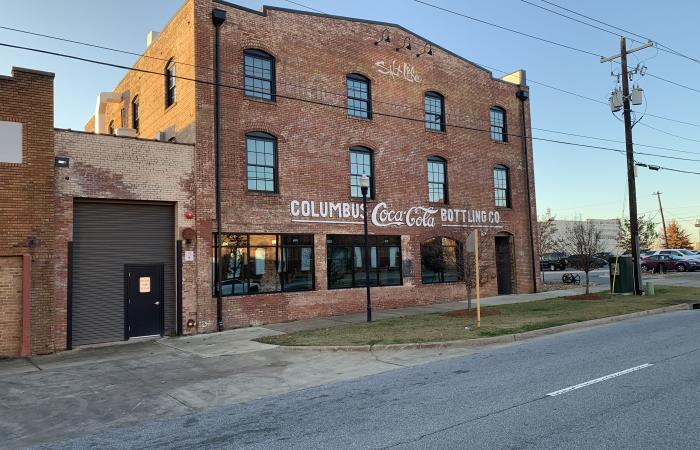Georgia adds five listings to National Register of Historic Places

Georgia added five new listings to the National Register of Historic Places.
The listings are:
- 1238 Professional Building, Columbus, Muscogee County
- Columbus Coca-Cola Bottling Company, Columbus, Muscogee County
- Ruben Gay Place, Fayetteville vicinity, Fayette County
- Maxeys Historic District, Maxeys, Oglethorpe County
- Dixie Cotton Mills and Mill Village Historic District, LaGrange, Troup County
Listing nominations are in line with the Historic Preservation Division’s (HPD) mission to promote the preservation and use of historic places for a better Georgia.
As of September 14, 2022, Georgia has 2,305 listings comprising 90,277 resources in the National Register of Historic Places.
HPD hopes sharing this information will encourage more historic property preservation through public awareness and an appreciation of the impact they have on our social and economic lives.
For more information on the newly added listings, see below:
Ruben Gay Place, Fayetteville vicinity, Fayette County
The Reuben Gay Place contains the extant resources of what was once a large farmstead and contributes to the understanding of the broad patterns of history that shaped the African American experience in rural Fayette County. The Reuben Gay Place was purchased by a formerly enslaved person, farmed by him and his descendants, and served for 140 years as a center of the African American community in Inman. In c.1882, Reuben Gay, Sr. (c.1830-1899) purchased 112 acres upon which to farm and raise his family. While much of the farmland itself is no longer extant, the dwelling, outbuildings, objects, and residual associated acreage remain in the same family. At the time of purchase and through the historic period (1972), the Reuben Gay Place represented the most land owned among his closest neighbors and demonstrated a rarely achievable goal for African Americans in the post-antebellum South. In the decades following the establishment of the Reuben Gay Place, the property and dwelling was an accommodating and safe place in which the family and the nearby African American community could gather, socialize, and celebrate life events.
The Ruben Gay Place was listed in the National Register of Historic Places on July 5, 2022. The nomination was sponsored and prepared by the descendants and relatives of Reuben Gay, Sr.
Dixie Cotton Mills and Mill Village Historic District, LaGrange, Troup County
Dixie Cotton Mills and Mill Village Historic District, located approximately one mile east of downtown LaGrange, is composed of a mill complex and mill village constructed between 1896 and the 1940s. The district represents Georgia’s late 19th- and early-20th century development of manufacturing mills with associated mill villages. The mill complex includes a row of five historic warehouses, an office building, a transformer house, and a modern smokestack. In the one- and two-story, red brick mill buildings, various textile products were produced. Additionally, Dixie Cotton Mills constructed mill housing through the mid-20th century. Houses in the mill village are single-family and duplex, wood-framed buildings with masonry foundations, front porches, and common setbacks. House types include saltbox, shotgun, double-shotgun, pyramidal cottages, gable-on-hip cottages, side-gabled and gabled wing cottages, all with relatively simple layouts.
Dixie Cotton Mills and Mill Village Historic District was listed in the National Register of Historic Places on July 29, 2022. The nomination was sponsored by the City of LaGrange, and nomination materials were prepared by Ray, Ellis & LaBrie Consulting, LLC.
Maxeys Historic District, Maxeys, Oglethorpe County
Maxeys Historic District is a rural community and agricultural center that developed around the railroad line between the late-19th and early-20th centuries. After the arrival of the Georgia Railroad in 1847, the small town began to prosper as a center of commerce for the surrounding agricultural-based economy. The district is an example of a railroad strip town whereby the railroad tracks run through the center of town. The main road parallels the tracks, with commercial and residential development oriented directly to the tracks. As the town’s early economy relied on the railroad and the distribution of cotton and other farm produce and supplies, the town plan naturally focused on the railroad. The district’s architecture presents a representative collection of commercial, religious, and agricultural buildings commonly found in rural Georgia towns with several residential types and styles popular in Georgia between the 1840s and 1970s. House types found in Maxeys Historic District include double pen, saddlebag, central hall, New South cottage, gabled wing cottage, Queen Anne cottage, pyramidal cottage, Georgian cottage, Georgian house, plantation plain, bungalow, and ranch houses. Architectural stylistic influences include Folk Victorian, Greek Revival, Italianate, Gothic Revival, Colonial Revival, and Craftsman.
Maxeys Historic District was listed in the National Register of Historic Places on September 2, 2022. The nomination was sponsored by the Maxeys Historic Interest Group, and nomination materials were prepared by Lydia Joffray of the Northeast Georgia Regional Commission.
1238 Professional Building, Columbus, Muscogee County
Built in 1949, the 1238 Professional Building is located in downtown Columbus, several blocks east of the Chattahoochee River. The building, which was designed by Wilbur D. Talley, is a good representative example of an International-Style building in Columbus. Character-defining features include a flat roof without eaves terminating flush with the wall plane, smooth wall surfaces, and large expanses of windows. Ideals of simple forms and self-expressive materials are evident in the composition of the main façade, which is broken into two horizontal segments. On the upper level, ribbon windows are grouped together to form a large expanse of glass nearly flush to the exterior wall plane, while dark green marble panels topped with steel framed windows give the effect of a visual recess of the building’s lower-level façade plane. The overall impression is one of simple lines flowing horizontally, visually expanding the building’s relatively narrow 35-foot-wide front façade. During a recent rehabilitation project, the building’s first floor retained its office spaces while the second floor was converted to accommodate three residential living units. The 1238 Professional Building functions as an important entry on the architectural timeline that defines the evolution of building styles in Columbus.
1238 Professional Building was listed in the National Register of Historic Places on July 1, 2022. The nomination was sponsored and prepared by the building’s owner.
Columbus Coca-Cola Bottling Company, Columbus Muscogee County
The Columbus Coca-Cola Bottling Company, an early and intact Coca-Cola Bottling Company facility, played an important role in the industrial and commercial activities of downtown Columbus. This franchise was owned and operated by Columbus Roberts, Sr., a grocer originally from Beulah, Alabama, who set up shop in the rear portion of a downtown Columbus drugstore and began bottling Coca-Cola in 1902, shortly after securing one of the earliest bottling franchises in the state. The first year of operation, the plant bottled almost 2,000 gallons of syrup, nearly doubling the quota required in its contract, and delivered these bottles across the region via a single mule-drawn wagon. Production quickly expanded and in 1905, Roberts moved his operations to this newly constructed three-story brick building on 6th Avenue. Over the next several decades, bottling production continued to increase and technologies advanced, and by 1932, the plant was producing 86 bottles of Coca-Cola per minute and its delivery fleet had grown to 12 trucks. This growth and increased distribution necessitated a larger warehouse space and easy access to the plant’s bottled stock, resulting in the two c.1928 additions. According to Constance L. Hays in The Real Thing, Truth and Power at the Coca-Cola Company, bottlers, like the Columbus operation, were “‘as indigenous to the American scene as the post office or the fire department,’ becoming fixtures that towns couldn’t remember how they’d done without.” The Columbus operation sowed its profits back into the business, and in turn, helped grow the local economies with increased staff and continued investments.
Columbus Coca-Cola Bottling Company was listed in the National Register of Historic Places on August 22, 2022. The nomination was sponsored by 1147, LLC, and nomination materials were prepared by Ken Henson.
HPD’s programs include environmental review, grants, historic resource surveys, tax incentives for rehabilitation, the National Register of Historic Places, and community and technical assistance. To learn more about HPD and its mission to promote the preservation and use of historic places for a better Georgia, click here.



